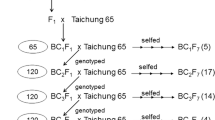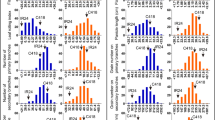Abstract
Exploitation of heterosis has brought significant advance in plant breeding and agricultural production, although its genetic basis is still poorly understood. In this study, a total of 66 chromosome segment substitution (CSS) lines, derived from a cross between japonica rice inbred line Asominori (as the recurrent parent) and indica rice inbred line IR24 (as the donor parent), were used to investigate the genetic basis of heterosis in indica × japonica inter-subspecific rice hybrids. Each CSS line was crossed with the background parent Asominori, and the heterosis of F1 hybrids was estimated by comparing the F1 performance with its two parental lines. Field experiments were carried out across six different environments to evaluate yield and yield-related traits in the 66 CSS lines and their 66 corresponding F1 hybrids. Quantitative trait loci (QTL) analyses were conducted using a likelihood ratio test based on the stepwise regression. Thirty-six QTL were identified with significant effects in CSSL, 21 with significant effects in hybrids and 13 with significant effects in both. On the basis of average dominance degree, of all the 70 QTL affecting yield-related agronomic traits, 28.6% (20) showed an overdominance, 35.7% (25) a partial dominance and 30% (21) an additive effect, indicating that all effects contribute to trait variation in japonica–indica rice hybrids. Effects of these QTL were examined to identify Indica rice chromosome segments of interest for the improvement of japonica inbred lines and hybrids.


Similar content being viewed by others
References
Abdelkhalik AF, Shishido R, Nomura K, Ikehashi H (2005) QTL-based analysis of heterosis for grain shape traits and seedling characteristics in an indica–japonica hybrid in rice (Oryza sativa L.). Breed Sci 55:41–48
Belknap JK (2003) Chromosome substitution strains: some quantitative considerations for genome scans and fine mapping. Mamm Genome 14:723–732
Bruce AB (1910) The Mendelian theory of heredity and the augmentation of vigor. Science 32:627–628
Cockerham CC, Zeng ZB (1996) Design III with marker loci. Genetics 143:1437–1456
Coors JG, Pandey S (1999) The genetics and exploitation of heterosis in crops. American Society of Agronomy, Crop Science Society of America, and Soil Science Society of America, Madison
Crow JF (1948) Alternative hypotheses of hybrid vigor. Genetics 33:477–487
Crow JF (1952) Dominance and overdominance. In: Gowen JW (ed) Heterosis. Iowa State College Press, Ames, pp 282–297
Crow JF (1999) Dominance and overdominance. In: Coors JG, Pandey S (eds) The genetics and exploitation of heterosis in crops. American Society of Agronomy, Madison, pp 49–58
Davenport CB (1908) Degeneration, albinism and inbreeding. Science 28:454–455
Duvick DN (2001) Biotechnology in the 1930s: the development of hybrid maize. Nat Rev Genet 2:69–74
East EM (1908) Inbreeding in corn. In: Reports of the connecticut agricultural experiment station for years 1907–1908, pp 419–428
East EM (1936) Heterosis. Genetics 21:375–397
Goodnight CJ (1999) Epistasis and heterosis. In: Coors JG, Pandey S (eds) The genetics and exploitation of heterosis in crops. American Society of Agronomy, Madison, pp 59–67
Holland JB, Nyquist WE, Cervantes-Martínez CT (2003) Estimating and interpreting heritability for plant breeding: an update. Plant Breed Rev 22:9–112
Howell PM, Lydiate DJ, Marshall DF (1996) Towards developing intervarietal substitution lines in Brassica napus using marker-assisted selection. Genome 39:348–358
Hua JP, Xing YZ, Xu CG, Sun XL, Yu SB, Zhang QF (2002) Genetic dissection of an elite rice hybrid revealed that heterozygotes are not always advantageous for performance. Genetics 162:1885–1895
Hua JP, Xing YZ, Wu WR, Xu CG, Sun XL, Yu SB, Zhang QF (2003) Single-locus heterotic effects and dominance by dominance interactions can adequately explain the genetic basis of heterosis in an elite rice hybrid. Proc Natl Acad Sci USA 100:2574–2579
Jones DF (1917) Dominance of linked factors as a means of accounting for heterosis. Genetics 2:466–479
Kubo T, Nakamura K, Yoshimura A (1999a) Development of a series of Indica chromosome segment substitution lines in Japonica background of rice. Rice Genet Newsl 16:104–106
Kubo T, Eguchi M, Yoshimura A (1999b) A new gene for F1 pollen sterility in Japonica/Indica cross of rice. Rice Genet Newsl 17:63–64
Kubo T, Aida Y, Nakamura K, Tsunematsu H, Doi K, Yoshimura A (2002) Reciprocal chromosome segment substitution series derived from japonica and indica cross of rice (Oryza sativa L). Breed Sci 52:319–325
Kusterer B, Muminovic J, Utz HF, Piepho H-P, Barth S, Heckenberger M, Meyer RC, Altmann T, Melchinger AE (2007) Analysis of a triple testcross design with recombinant inbred lines reveals a significant role of epistasis in heterosis for biomass-related traits in Arabidopsis. Genetics 175:2009–2017
Li ZK, Pinson SRM, Paterson AH, Park WD, Stansel JW (1997) Epistasis for three grain yield components in rice (Oryza sativa L.). Genetics 145:453–465
Li ZK, Luo LJ, Mei HW, Wang DL, Shu QY, Tabien R, Zhong DB, Ying CS, Stansel JW, Khush GS, Paterson AH (2001) Overdominant epistatic loci are the primary genetic basis of inbreeding depression and heterosis in rice I. Biomass and grain yield. Genetics 158:1737–1753
Li H, Ye G, Wang J (2007) A modified algorithm for the improvement of composite interval mapping. Genetics 175:361–374
Li LZ, Lu KY, Chen ZM, Mu TM, Hu ZL, Li XQ (2008) Dominance, overdominance and epistasis condition the heterosis in two heterotic rice hybrids. Genetics 180:1725–1742
Lippman ZB, Zamir D (2007) Heterosis: revisiting the magic. Trend Genet 23:60–66
Luo LJ, Li ZK, Mei HW, Shu QY, Tabien R, Zhong DB, Ying CS, Stansel JW, Khush GS, Paterson AH (2001) Overdominant epistatic loci are the primary genetic basis of inbreeding depression and heterosis in rice II. Grain yield components. Genetics 158:1755–1771
Ma GH and Yuan LP (2003) Hybrid rice achievements and development in China. The 4th International Symposium on Hybrid Rice, Hanoi, Vietnam, 14–17 May 2002
McCouch SR (2008) CGSNL (Committee on Gene Symbolization, Nomenclature and Linkage, Rice Genetics Cooperative) Gene nomenclature system for rice. Rice 1:72–84
McCouch SR, Teytelman L, Xu YB, Lobos KB, Clare K, Walton M, Fu BY, Maghirang R, Li ZK, Xing YZ, Zhang QF, Kono I, Yano M, Fjellstrom R, Declerck G, Schneider D, Cartinhour S, Ware D, Stein L (2002) Development and mapping of 2240 new SSR markers for rice (Oryza sativa L.). DNA Res 9:199–207
Mei HW, Luo LJ, Ying CS, Wang YP, Yu XQ, Guo LB, Paterson AH, Li ZK (2003) Gene actions of QTLs affecting several agronomic traits resolved in a recombinant inbred rice population and two testcross populations. Theor Appl Genet 107:89–101
Mei HW, Li ZK, Shu QY, Guo LB, Wang YP, Yu XQ, Ying CS, Luo LJ (2005) Gene actions of QTL affecting several agronomic traits resolved in a recombinant inbred rice population and two backcross populations. Theor Appl Genet 110:649–659
Melchinger AE, Piepho H-P, Utz HF, Muminovic J, Wegenast T, Törjék O, Altmann T, Kusterer B (2007) Genetic basis of heterosis for growth-related traits in Arabidopsis investigated by testcross progenies of near-isogenic lines reveals a significant role of epistasis. Genetics 177:1827–1837
Nyquist WE (1991) Estimation of heritability and prediction of selection response in plant populations. Crit Rev Plant Sci 10:235–322
Schnell FW, Cockerham CC (1992) Multiplicative vs. arbitrary gene action in heterosis. Genetics 131:461–469
Schön C, Dhillon B, Utz H, Melchinger A (2010) High congruency of QTL positions for heterosis of grain yield in three crosses of maize. Theor Appl Genet 120:321–332
Semel Y, Nissenbaum J, Menda N, Zinder M, Krieger U, Issman N, Pleban T, Lippman Z, Gur A, Zamir D (2006) Overdominant quantitative trait loci for yield and fitness in tomato. Proc Natl Acad Sci USA 103:12981–12986
Shull GH (1908) The composition of a field of maize. Ann Breeders’ Assoc Rep 4:296–301
Stuber CW (1994) Heterosis in plant breeding. Plant Breed Rev 12:227–251
Stuber CW, Edwards MD, Wendel JF (1987) Molecular marker-facilitated investigation of quantitative trait loci in maize. II. Factors influencing yields and its component traits. Crop Sci 27:639–648
Stuber CW, Lincoln SE, Wolff DW, Helentjaris T, Lander ES (1992) Identification of genetic factors contributing to heterosis in a hybrid from two elite maize inbred lines using molecular markers. Genetics 132:823–839
Tsunematsu H, Yoshimura A, Harushima Y, Nagamura Y, Kurata N, Yano M, Sasaki T, Iwata N (1996) RFLP framework map using recombinant inbred lines in rice. Breed Sci 46:279–284
Wan JM, Yamaguchi Y, Kato H, Ikehashi H (1996) Two new loci for hybrid sterility in cultivated rice (Oryza sativa L.). Theor Appl Genet 92:183–190
Wang J (2009) Inclusive composite interval mapping of quantitative trait genes. Acta Agronomica Sinica 35(2):239–245
Wang J, Wan X, Crossa J, Crouch J, Weng J, Zhai H, Wan J (2006) QTL mapping of grain length in rice (Oryza sativa L.) using chromosome segment substitution lines. Genet Res 88:93–104
Wang J, Wan X, Li H, Pfeiffer WH, Crouch J, Wan J (2007) Application of identified QTL-marker associations in rice quality improvement through a design breeding approach. Theor Appl Genet 115:87–100
Williams W (1959) Heterosis and the genetics of complex characters. Nature 184:527–530
Xiao JH, Li JM, Yuan LP, Tanksley SD (1995) Dominance is the major genetic basis of heterosis in rice as revealed by QTL analysis using molecular markers. Genetics 140:745–754
Xiao JH, Li JM, Yuan LP, Tanksley SD (1996) Identification of QTLs affecting traits of agronomic importance in a recombinant inbred population derived from a subspecific cross. Theor Appl Genet 92:230–244
Xiao JH, Li JM, Grandillo S, Ahn SN, Yuan L, Tanksley SD, McCouch SR (1998) Identification of trait-improving quantitative trait loci alleles from a wild rice relative, Oryza rufipogon. Genetics 150:899–909
Yu SB, Li JX, Xu CG, Tan YF, Gao YJ, Li XH, Zhang QF, Maroof MAS (1997) Importance of epistasis as the genetic basis of heterosis in an elite rice hybrid. Proc Natl Acad Sci USA 94:9226–9231
Yu CY, Wan JM, Zhai HQ, Wang CM, Jiang L, Xiao YH, Liu YQ (2005) Study on heterosis of inter-subspecies between indica and japonica rice (Oryza sativa L.) using chromosome segment substitution lines. Chin Sci Bull 50:131–136
Yuan LP (2003) Recent progress in breeding super hybrid rice in China. The 4th International Symposium on Hybrid Rice, Hanoi, Vietnam, 14–17 May 2002
Zhao ZG, Jiang L, Zhang WW, Yu CY, Zhu SS, Xie K, Tian H, Liu LL, Ikehashi H, Wan JM (2007) Fine mapping of S31, a gene responsible for hybrid embryo-sac abortion in rice (Oryza sativa L.). Planta 226:1087–1096
Acknowledgments
We thank the editor and two anonymous reviewers for their constructive comments which significantly improved the manuscript. We also thank Professor A. Yoshimura, Kyushu University, Japan, for kindly providing us with the CSS lines population. This research is supported by the grants from the 863 Program of China (2009AA101101), the 973 Program of China (2011CB100102), the earmarked fund for Modern Agro-industry Technology Research System, Jiangsu Science and Technology Development Program (BE2009301-3), and PAPD project.
Author information
Authors and Affiliations
Corresponding author
Additional information
Communicated by A. Charcosset.
Rights and permissions
About this article
Cite this article
Wang, Z., Yu, C., Liu, X. et al. Identification of Indica rice chromosome segments for the improvement of Japonica inbreds and hybrids. Theor Appl Genet 124, 1351–1364 (2012). https://doi.org/10.1007/s00122-012-1792-z
Received:
Accepted:
Published:
Issue Date:
DOI: https://doi.org/10.1007/s00122-012-1792-z




